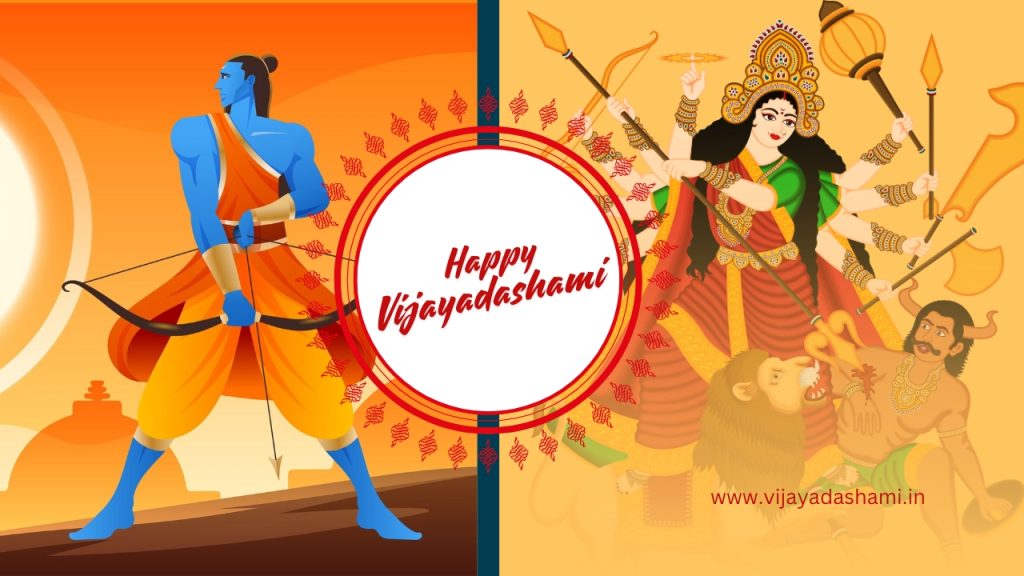Vijayadashami, also known as Dussehra, is a vibrant festival celebrated across India and among Hindu communities worldwide. Marking the victory of good over evil, Dussehra commemorates mythological stories like Lord Rama’s defeat of the demon king Ravana and Goddess Durga’s triumph over Mahishasura. This festival is not just a celebration but a reminder of age-old values and the power of righteousness. Understanding Dussehra offers insight into India’s rich cultural heritage and the values that have inspired millions for generations.
About Vijayadashami
Vijayadashami has roots in Hindu mythology, primarily the Ramayana and Mahabharata:
- Ramayana Influence: Vijayadashami symbolizes the day Lord Rama defeated Ravana, who had abducted his wife, Sita. This victory represents the triumph of good over evil and is celebrated with dramatic Ramlila performances in North India.
- Mahabharata Connection: The Pandavas are believed to have revealed their weapons hidden in a Shami tree on Vijayadashami, marking their readiness to reclaim their kingdom after 13 years of exile.
Cultural Significance of Vijayadashami
Vijayadashami (Dussehra) is celebrated on the tenth day of the Hindu lunar month of Ashvin, typically in late September or October. The festival reinforces values such as courage, honor, and devotion:
- Symbolism of Victory: Both Lord Rama and Goddess Durga’s victories symbolize the power of righteousness.
- Universal Appeal: While rooted in Hindu tradition, the messages of resilience and justice resonate beyond any single culture or religion.
Regional Celebrations Across India
The celebration of Vijayadashami festival varies widely across India, reflecting the country’s diverse culture:
- North India: Cities like Delhi and Varanasi hold grand Ramlila performances, where actors reenact the story of Lord Rama, culminating in the burning of Ravana’s effigies.
- West Bengal: Known as Durga Puja, Vijayadashami coincides with the final day of this festival, where people celebrate Goddess Durga’s victory over Mahishasura. The celebration involves elaborate pandals, idol immersions, and community gatherings.
- Mysuru, Karnataka: Mysuru Vijayadashami is a royal affair with grand processions featuring caparisoned elephants, music, and traditional performances.
- Kullu, Himachal Pradesh: The Vijayadashami festival in Kullu spans a week and draws tribes from across the region, honoring local deities and showcasing regional customs.
Modern Observances and Emerging Trends
In recent years, Vijayadashami (Dussehra) celebrations have adapted to include modern, eco-conscious practices:
- Eco-Friendly Effigies: Effigies of Ravana, often burned during Vijayadashami (Dussehra), are increasingly being crafted from biodegradable materials to reduce environmental impact.
- Virtual Celebrations: Some cities now offer live-streamed Ramlila performances and cultural events, allowing a global audience to participate.
- Cultural Tourism: Vijayadashami (Dussehra) has become a significant attraction for travelers, with cities like Mysuru and Kolkata seeing an increase in visitors eager to experience the vibrant festivities.
Key Rituals and Customs
- Effigy Burning: Effigies of Ravana, Meghnath, and Kumbhkaran are set alight in various cities, symbolizing the eradication of evil.
- Worship of Weapons and Tools: Known as Ayudha Puja, people worship weapons, vehicles, and tools as symbols of livelihood and strength.
- Vijayadashami Processions: Grand parades showcase local music, dance, and artistry, highlighting India’s cultural richness.
Dussehra in Popular Culture and News
With changing times, some unique practices and recent updates have emerged in Dussehra celebrations:
- Sustainable Dussehra: Cities are making Dussehra celebrations more environmentally friendly, with special focus on limiting pollution and waste.
- Highlight on Tradition: Due to recent renewals in cultural preservation, there’s growing appreciation for traditional Dussehra events and values.
FAQs
-
What is Dussehra, and why is it celebrated?
Dussehra, or Vijayadashami, marks the victory of good over evil, celebrated in honor of Lord Rama’s triumph over Ravana and Goddess Durga’s victory over Mahishasura.
-
When is Dussehra celebrated?
Dussehra falls on the tenth day of the Hindu month of Ashvin, usually in late September or October, following the nine days of Navratri.
-
How is Dussehra celebrated in different parts of India?
In North India, effigies of Ravana are burned. In Bengal, Dussehra coincides with the end of Durga Puja, and Mysuru in Karnataka is known for its royal processions.
-
What is the significance of burning Ravana’s effigy?
Burning Ravana’s effigy symbolizes the eradication of evil, serving as a reminder of the victory of righteousness.
-
Are there eco-friendly practices for Dussehra celebrations?
Yes, many communities are adopting eco-friendly materials for effigies and decorations to minimize environmental impact.
-
Is Dussehra a public holiday in India?
Yes, Dussehra is a gazetted holiday in India, with government offices, schools, and businesses generally closed.
-
What’s the connection between Navratri and Dussehra?
Navratri is a nine-day festival of worship and celebration of the feminine divine, culminating in Dussehra, symbolizing victory and renewal.
-
How can I participate in Dussehra if I’m outside India?
Many Dussehra events are live-streamed, allowing you to join in from anywhere, and you can participate in local cultural events hosted by Hindu communities worldwide.
Conclusion on What is Vijayadashami
Dussehra’s (Vijayadashami) appeal lies in its universal message of good triumphing over evil, a theme that resonates with people from all backgrounds. From its mythological roots to the vibrant regional celebrations, Dussehra is both a cultural celebration and a reflection on moral strength. Whether one attends for spiritual reasons or to experience India’s cultural diversity, Dussehra remains a powerful celebration of values that continue to inspire. Have you celebrated Dussehra before? Share your experiences, and if you’re planning to participate this year, invite friends to join you in this meaningful festival.

